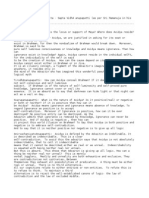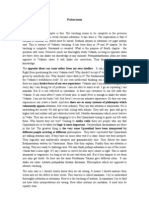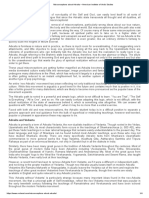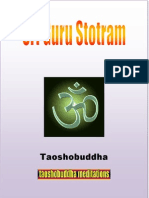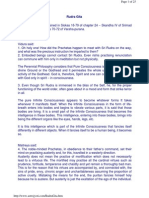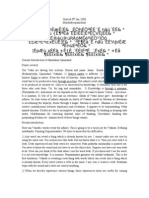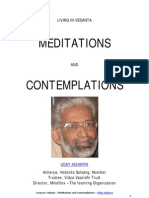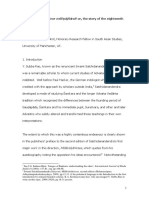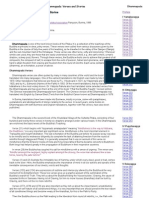Brahmasutra Adhyaasa Bhaashyam
Brahmasutra Adhyaasa Bhaashyam
Uploaded by
Uday AcharyaCopyright:
Available Formats
Brahmasutra Adhyaasa Bhaashyam
Brahmasutra Adhyaasa Bhaashyam
Uploaded by
Uday AcharyaCopyright
Available Formats
Share this document
Did you find this document useful?
Is this content inappropriate?
Copyright:
Available Formats
Brahmasutra Adhyaasa Bhaashyam
Brahmasutra Adhyaasa Bhaashyam
Uploaded by
Uday AcharyaCopyright:
Available Formats
Brahmasutras
Adhyasa Bhashyam Bhagavatpaada Adi Shankaracharya Translation Uday Acharya AXyas> Superimposition
Objection: The words and the meanings of You and I which are in the nature of object and subject are mutually opposed like darkness and light. When it is evident that they cannot assume the nature of each other, much less can their attributes be mutually transposed.
Hence, the superimposition of the object (the meaning of the word You), and its attributes, on the conscious subject (the meaning of the word I), and conversely, the superimposition of the subject and its attributes on the object, can only be considered false.
Vedantin: Yet, it is natural human practice rooted in wrong knowledge to assume I am this or This is mine by superimposing upon each the characteristic nature and the attributes of the other.
They are unable to distinguish between real and unreal and their respective attributes, although they are absolutely distinct.
Question: What is Adhyaasa (superimposition)? Reply: It is the illusory appearance, similar to memory, of something previously experienced, seen elsewhere.
Some define it (Adhyaasa) as the superimposition of attributes of one thing on another.
Others, again, define Adhyaasa as the delusion born of nonperception of difference (between the superimposed and the locus of superimposition.)
Others, however, say that whenever superimposition occurs, locus appears as possessing a contradictory attribute.
But there is no contradiction as to (the definition regarding superimposition being) the appearance of attributes of one thing on something else.
We experience in the world ( illustrations of Adhyaasa ) a shell appears as if it were silver; one moon appears as two.
Objection: But how is possible that the inner Self which is not an object be mistaken for an object or its attributes? People only mistake object that is present nearby (i.e. perceptible) to be some other object. The inner Self, unassociated with the concept of You is a non-object according to you.
Vedantin: The Self is not an absolute non-object, for it is the object of the I concept. Also the self is universally known for its nature is Aparoksha (immediate, never indirect).
Again there is no rule that one should only mistake an object situated nearby (i.e. perceptible) for another object. Children conclude that the (imperceptible) sky has attributes like surface (dome shaped) and impurities (overcast) etc. Hence there is no contradiction for the non-self to be mistaken for the inner Self.
The wise consider Adhyaasa, thus defined, to be ignorance (Avidyaa). Knowledge (Vidyaa) is the ascertainment of the real nature through discriminative analysis. Thus, the locus of superimposition does not associate with the defects or merits (of the superimposed entity) even to the smallest degree.
It is because of Adhyaasa (also known as Avidyaa) between the Self and non-self, that all empirical activity relating to knowledge and its means become possible. All the scriptures referring to injunctions, prohibitions, and liberation too (presuppose this superimposition)
Doubt: But how can the means of valid knowledge such as perception, (inference) etc., and scriptural texts reveal things that fall within Avidyaa? Vedantin: A person cannot be a knower (pramaataa) without the identification with body and senses, in terms of I and mine, and consequently the means of knowledge cannot be operated. For without the employment of the senses, perception and the other means of valid knowledge cannot operate. The senses too cannot function without a physical basis.
Without a superimposed I notion, the body cannot undertake independent activity. In the absence of all these (conditions), the unconnected Self cannot become a knower. And, without a knower, there is no way by which the means of knowledge can operate. Hence perception and the other means of knowledge, including the scriptural texts fall within the scope of Avidyaa.
This also follows from the non-difference (in the activities of humans as compared) with animals. When animals etc. become aware through the contact of the senses (ears etc.) and objects (sounds etc.), they withdraw from the unpleasant and are drawn towards the pleasant. For instance, the cow runs away seeing a person approaching with a raised stick thinking He wants to hit me, whereas it moves eagerly towards a person whose hand is full of green grass. The wise person too acts similarly ay by withdrawing from strong, fierce-eyed, screaming people wielding swords, and approach people of the opposite type.
Therefore, men and animals are the same in transactions concerning knowledge and its means. Perception and other transactions of an animal are clearly known to be based on non-discrimination (between its body and its self). Going by this similarity, we conclude that the perception and other transactions of even the enlightened person, at that instant, is (based on) similar (grounds of avidyaa).
In case of transactions connected to scriptures, it is true that the person eligible (for such activity) is intelligent and not ignorant of the selfs connection to the other world (after death).
However, this qualification does not include self knowledge born Vedanta the self which is beyond hunger and thirst, bereft from differences like priest, warrior, and free from birth and death, for such knowledge is neither helpful (for rituals), nor is it compatible with the qualifications (for rituals).
Prior to revelation of Self knowledge, the scriptures operate within the scope of ignorance and do not transgress it. For instance, texts like A Braahmana shall sacrifice operate by assuming superimposition of specific conditions like profession, life-stage, age on the self.
We have earlier stated that Adhyaasa is the cognition of something on something different from it. A person superimposes external attributes on himself; for instance, he thinks himself as able or disabled if his wife, or son is able or disabled. Similarly he superimposes physical attributes on himself saying, I am fat, lean, fair, standing, walking or jumping; He superimposes the sensory attributes on himself saying I am dumb, one eyed, impotent, deaf or blind.He superimposes on himself mental attributes like desire, resolve, doubt, understanding, etc.
In this way superimposing (external attributes) on the inner Self which is the object of the I concept and witness of all activities (superimposed on it), one conversely superimposes the inner self witness of all, on the mind, (body) etc.
Thus, the beginningless and endless natural superimposition, in the nature of mistaken cognition, and source of agency, enjoyership, etc. is directly experienced by one and all. The study of the Vedanta texts is begun now, for the purpose of eliminating this cause of sorrow, and for gaining knowledge of oneness of Self. That all the Vedanta texts have this purport, we shall demonstrate in this analytical study (Mimaamsaa) with respect to the Self (Shaariraka). ------------
You might also like
- !, ,,$?-Ej - (J/-0R:C-2 - R3-2 ?-:PR-.R/-3#:-H2-3-28$?-?RDocument13 pages!, ,,$?-Ej - (J/-0R:C-2 - R3-2 ?-:PR-.R/-3#:-H2-3-28$?-?RDenjen DoudenNo ratings yet
- Intro Sri RudramDocument5 pagesIntro Sri RudramRavi Chandran NudurumatiNo ratings yet
- Sapta Vidha Anupapatti - Seven UntenablesDocument2 pagesSapta Vidha Anupapatti - Seven Untenablesraj100% (1)
- Swami Dayananda SaraswatiDocument3 pagesSwami Dayananda Saraswatimal_sri6798No ratings yet
- 47 - 01A Panchadasi Text & NotesDocument112 pages47 - 01A Panchadasi Text & NotesRonnie Williams100% (4)
- Anubhava (Experience?)Document2 pagesAnubhava (Experience?)Baiju GujarathiNo ratings yet
- Advaita Pancharatnam PDFDocument25 pagesAdvaita Pancharatnam PDFNarayanan MuthuswamyNo ratings yet
- Mandukya Upanishad Alatasanti PrakaranamDocument86 pagesMandukya Upanishad Alatasanti Prakaranamraj75% (4)
- Tapovan ShatkamDocument29 pagesTapovan Shatkamnaveen kumarNo ratings yet
- 47.05 Panchadasi Book 05112Document50 pages47.05 Panchadasi Book 05112srivatsaNo ratings yet
- Adhyasa or SuperimpositionDocument6 pagesAdhyasa or SuperimpositionJeyashankar Ramakrishnan100% (1)
- 01 Aparokshanubhuti Volume 01 PDFDocument186 pages01 Aparokshanubhuti Volume 01 PDFRajashekhar100% (1)
- THE MESSAGE OF THE BRIHADARANYAKA UPANISHAd 2Document10 pagesTHE MESSAGE OF THE BRIHADARANYAKA UPANISHAd 2Satyendra Nath DwivediNo ratings yet
- Satsang With Sri Swami Dayananda Saraswati Arsha Vidya Gurukulam Assimilating VedantaDocument3 pagesSatsang With Sri Swami Dayananda Saraswati Arsha Vidya Gurukulam Assimilating Vedantaprem19999No ratings yet
- WhenceAdhyasa PDFDocument72 pagesWhenceAdhyasa PDFunuujupukujuNo ratings yet
- Adhyaropa-Apavada - Superimposition and NegationDocument2 pagesAdhyaropa-Apavada - Superimposition and NegationSwami AjatanandaNo ratings yet
- Narada Bhakti Sutras - The Way or Yoga of Divine LoveDocument129 pagesNarada Bhakti Sutras - The Way or Yoga of Divine LoveSant Mat67% (3)
- The Message of The Upanishads 5Document12 pagesThe Message of The Upanishads 5Satyendra Nath DwivediNo ratings yet
- Understanding Reality in The Vision of Advaita VedantaDocument13 pagesUnderstanding Reality in The Vision of Advaita Vedantawolfgang_plaschgNo ratings yet
- Amrita BinduDocument4 pagesAmrita BinduSerene In0% (1)
- Sadhana Panchakam - 40 Instructions - SatyavedismDocument7 pagesSadhana Panchakam - 40 Instructions - SatyavedismPrashantNo ratings yet
- Dialogue Between Uddalaka and SvetaketuDocument5 pagesDialogue Between Uddalaka and Svetaketuanon_294330152No ratings yet
- The Value of AcceptanceDocument7 pagesThe Value of AcceptanceTaraSwainNo ratings yet
- Amritabindupanishad - Translated by Swami MadhavanandaDocument3 pagesAmritabindupanishad - Translated by Swami Madhavanandaapi-19985927No ratings yet
- Vedanta DindimaDocument238 pagesVedanta DindimaRamNo ratings yet
- Advaita Makaranda With Rasa-AbhivyanjikaDocument161 pagesAdvaita Makaranda With Rasa-AbhivyanjikaantiX LinuxNo ratings yet
- A Look at Three Upanishads: Mandukya, Taittiriya, and ChandogyaDocument31 pagesA Look at Three Upanishads: Mandukya, Taittiriya, and ChandogyajohnkalespiNo ratings yet
- Atman 3Document8 pagesAtman 3Suresh Lakshmi NarasimhanNo ratings yet
- Meaning - Dakshinamurti UpanishadDocument5 pagesMeaning - Dakshinamurti UpanishadAnand GNo ratings yet
- Misconceptions About AdvaitaDocument4 pagesMisconceptions About AdvaitaJavierNo ratings yet
- Profound Q & A On VedantaDocument62 pagesProfound Q & A On VedantafaisalNo ratings yet
- Kena Upanishad: Brahmanam of The SamavedaDocument9 pagesKena Upanishad: Brahmanam of The Samavedapsrve696No ratings yet
- Sri Guru StotramDocument9 pagesSri Guru StotramTaoshobuddha100% (1)
- Advaita Handbook by S.N. Sastri JiDocument76 pagesAdvaita Handbook by S.N. Sastri JiPrashānt ParikhNo ratings yet
- श्रीदक्षिणामूर्तिस्तोत्रम् (अनुवादसहितम्)Document12 pagesश्रीदक्षिणामूर्तिस्तोत्रम् (अनुवादसहितम्)Kamesh RaghavendraNo ratings yet
- Durga Pancharatnam by Sri Kanchi Chandrashekhara Saraswati Swamigal (Kanchi Paramacharya) Source & CreditsDocument4 pagesDurga Pancharatnam by Sri Kanchi Chandrashekhara Saraswati Swamigal (Kanchi Paramacharya) Source & Creditsr_sendhilNo ratings yet
- Sankhya PurusaDocument13 pagesSankhya Purusamohityadav1307No ratings yet
- 01 Dakshinamurthy Stotram PDFDocument119 pages01 Dakshinamurthy Stotram PDFPramoda Avadhani100% (1)
- Swami Ishwarananada Gita Talks-Sessions1-7Document135 pagesSwami Ishwarananada Gita Talks-Sessions1-7HimalayanWisdom100% (1)
- Pointers On Vedanta by Sri Swami BrahmanandaDocument252 pagesPointers On Vedanta by Sri Swami BrahmanandakartikscribdNo ratings yet
- Sadhanas According To Yoga Vasishtha PDFDocument43 pagesSadhanas According To Yoga Vasishtha PDFdevorani100% (1)
- Already EnlightenedDocument15 pagesAlready EnlightenediinselfNo ratings yet
- Panchadasi - V.krishnarajDocument15 pagesPanchadasi - V.krishnarajA SmithNo ratings yet
- The Neo Vedanta Philosophy of Swami Vivekananda PDFDocument18 pagesThe Neo Vedanta Philosophy of Swami Vivekananda PDFCesarGarciaNo ratings yet
- Rudra GitaDocument25 pagesRudra GitaPrabha VetrichelvanNo ratings yet
- HastamalakiyamDocument33 pagesHastamalakiyamvicknesh90No ratings yet
- Advaita Makaranda-1986 PDFDocument66 pagesAdvaita Makaranda-1986 PDFRonnie Williams80% (5)
- How To Find A Guru - Indiaspirituality BlogDocument4 pagesHow To Find A Guru - Indiaspirituality BlogIndiaspirituality Amrut100% (2)
- MandukyaUpanishad AgamaPrakaranamDocument233 pagesMandukyaUpanishad AgamaPrakaranamraj67% (3)
- YogaVasishta Upashama Prakaranam Part 9Document66 pagesYogaVasishta Upashama Prakaranam Part 9NeoHoodaNo ratings yet
- VedantaDarshanam Oct09Document49 pagesVedantaDarshanam Oct09RAMESHBABUNo ratings yet
- Swami Sivananda - Advice To SannyasinsDocument129 pagesSwami Sivananda - Advice To SannyasinsSex Free LifeNo ratings yet
- Tat Tvam AsiDocument5 pagesTat Tvam Asisagar_lal100% (1)
- Value of ValuesDocument6 pagesValue of ValuesprabhaNo ratings yet
- ब्रह्मज्ञानावलीमाला (Sa-En) YKDocument9 pagesब्रह्मज्ञानावलीमाला (Sa-En) YKHapayko100% (1)
- Essentials of Hindu Dharma Part FiveDocument2 pagesEssentials of Hindu Dharma Part FivesharmakovvaliNo ratings yet
- Dasha Shaanti MantraahDocument6 pagesDasha Shaanti MantraahUday AcharyaNo ratings yet
- Atma Bodha by Sri Sri Adi ShankaracharyaDocument10 pagesAtma Bodha by Sri Sri Adi ShankaracharyaUday Acharya67% (3)
- Living in Vedanta - MeditationsDocument91 pagesLiving in Vedanta - MeditationsUday AcharyaNo ratings yet
- Bhaja Govindam ItransDocument11 pagesBhaja Govindam ItransUday AcharyaNo ratings yet
- Article - Mumbai Mirror & Times of IndiaDocument6 pagesArticle - Mumbai Mirror & Times of IndiaUday Acharya100% (2)
- Sanaatana DharmaDocument34 pagesSanaatana DharmaUday Acharya100% (1)
- Articles - Asian AgeDocument48 pagesArticles - Asian AgeUday Acharya100% (2)
- Vdocuments - MX Karma Astrology For Srivaishnava2016 17Document6 pagesVdocuments - MX Karma Astrology For Srivaishnava2016 17PedroViamonteNo ratings yet
- Pure Dhamma 07december2017Document1,114 pagesPure Dhamma 07december2017Teguh KiyatnoNo ratings yet
- Guru StotramDocument4 pagesGuru StotramkoushikkeshavNo ratings yet
- Gitartha SangrahaDocument64 pagesGitartha SangrahaSUNDARNo ratings yet
- Prayers of A Sakya EmpowermentDocument4 pagesPrayers of A Sakya EmpowermentKyaw Tha KaiNo ratings yet
- Slokas On GuruDocument3 pagesSlokas On Gurubantyseth100% (1)
- Jnana-Karma SamuccayaDocument3 pagesJnana-Karma SamuccayaVaijayanthi ThirumalaiswamiNo ratings yet
- Dattaatreya Maalaa Mantra Stotram For Health, Wealth, Peace, Protection EtcDocument9 pagesDattaatreya Maalaa Mantra Stotram For Health, Wealth, Peace, Protection EtcHermit100% (11)
- Isha Translation Siddhartha KrishnaDocument6 pagesIsha Translation Siddhartha KrishnaSwami AdvayanandaNo ratings yet
- The Yoga Way of Life!: A Photographer Gets People To Pose For Him. A Yoga Instructor Gets People To Pose For ThemselvesDocument31 pagesThe Yoga Way of Life!: A Photographer Gets People To Pose For Him. A Yoga Instructor Gets People To Pose For ThemselvesKamalesh GogiNo ratings yet
- KADAMPA LAMRIM Contemplation-CardsDocument44 pagesKADAMPA LAMRIM Contemplation-CardsJose Luis Sanchez Navaro100% (1)
- Cultivating Mindfulness of Bodhichitta c5 PDFDocument12 pagesCultivating Mindfulness of Bodhichitta c5 PDFcatalinaNo ratings yet
- Yoga & MimamsaDocument6 pagesYoga & MimamsaV.F.No ratings yet
- Sankardeva and His Vedantic LeaningDocument11 pagesSankardeva and His Vedantic LeaningParan GoswamiNo ratings yet
- (Ebook - Eng) Diamond Sutra (Vajra Prajnaparamita Sutra - Chinese Version, Edited by The Buddhist Translation Society)Document12 pages(Ebook - Eng) Diamond Sutra (Vajra Prajnaparamita Sutra - Chinese Version, Edited by The Buddhist Translation Society)Jacopo StefaniNo ratings yet
- Marma PointsDocument5 pagesMarma Pointssonaliforex1No ratings yet
- Avidya Bhava Bija or Mithyajnana or TheDocument21 pagesAvidya Bhava Bija or Mithyajnana or TheB K MohantyNo ratings yet
- Personality in Indian PsychologyDocument13 pagesPersonality in Indian PsychologyJuan Luis Köstner MartinoNo ratings yet
- The Hindu Doctrine of The AtmanDocument6 pagesThe Hindu Doctrine of The Atmanrodrigo GuerraNo ratings yet
- Lakshmi Sahasranama Stotram - Hindupedia, The Hindu Encyclopedia PDFDocument36 pagesLakshmi Sahasranama Stotram - Hindupedia, The Hindu Encyclopedia PDFKajaruban SurendranNo ratings yet
- The Six PerfectionsDocument3 pagesThe Six Perfectionslongkhanh1987No ratings yet
- Sai Madhyan Aarti PDFDocument5 pagesSai Madhyan Aarti PDFchanellkistenNo ratings yet
- Gayatri GhanapathaDocument3 pagesGayatri GhanapathaSai SarathNo ratings yet
- Renunciation of Work Vs Work in DevotionDocument17 pagesRenunciation of Work Vs Work in DevotionSai KrishnaNo ratings yet
- Biografia Secreta de Lama Tsong KhapaDocument12 pagesBiografia Secreta de Lama Tsong KhapaCarlos MoralesNo ratings yet
- The Dhammapada Verses and ...Document4 pagesThe Dhammapada Verses and ...kriskrishnanNo ratings yet
- Esoteric Versus Tantric Tattvas TableDocument1 pageEsoteric Versus Tantric Tattvas TablePatricia ZawNo ratings yet
- WWW Manblunder Com Search Label Bhagavad 20gita Updated MaxDocument12 pagesWWW Manblunder Com Search Label Bhagavad 20gita Updated MaxVignesh SrinivasanNo ratings yet
- As Cinco Faces de ShivaDocument5 pagesAs Cinco Faces de Shivarobertokocenko2009No ratings yet


